Hey there, fish lovers! If you’re a fan of Betta fish, then you’re in for a treat. Today, we’re talking all about the different types of black Betta fish and what makes them so special. Now, I know what you’re thinking. “Black Betta fish? Don’t they all look the same?” Well, That is further from the truth. There are actually a bunch of different types of black Betta fish, each with its own unique features and personalities.
Whether you’re a seasoned Betta fish owner or just starting out, it’s important to know what you’re getting into. That’s why we’re here to give you the inside scoop on all the different types of black Betta fish out there. From the Black Orchid to the Black Copper, we’ll cover it all.
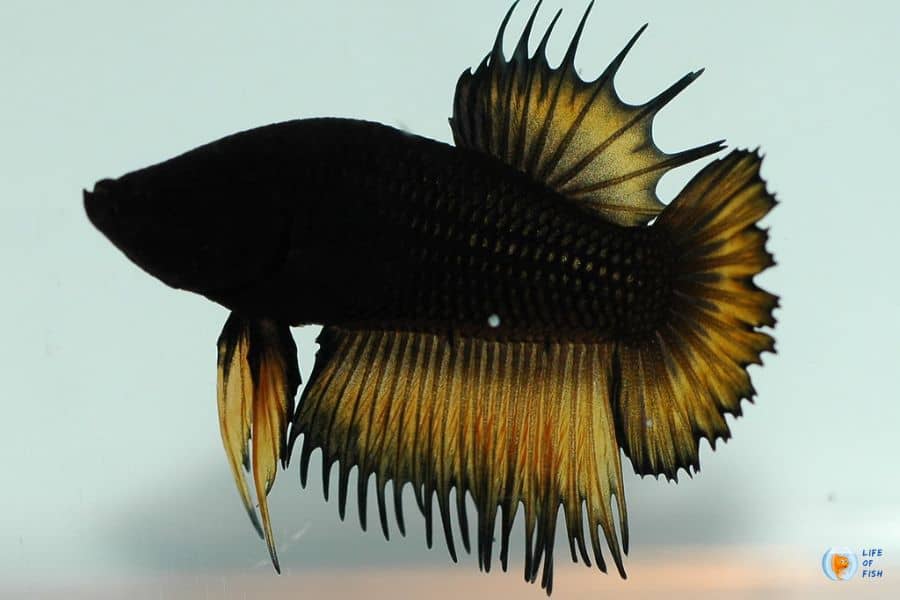
Black Melano Bettas
Black Melano Betta is the most famous type of Black Betta. In Black Melano Bettas, a mutated gene significantly increases the black pigment density and coverage area. In appearance, Black Melano Betta is a very dark blackfish. Sometimes Black Melano Betta’s coloration is so dense that it seems like the blue-black color of a raven’s wing. The mutated gene that is increased the black color is recessive to the normal black gene. This means that if you cross the Melano Betta with a normal Betta that does not have a mutated black gene, all spawns will be multi-colored. Those offspring will carry the melanium gene, but it is not visible in their coloration. These spawns, “melano genus”, are unable to distinguish from the common multicolored Betta . The recessive characteristics will become visible only if both parents of the spawn pass on the mutated gene to their offspring.
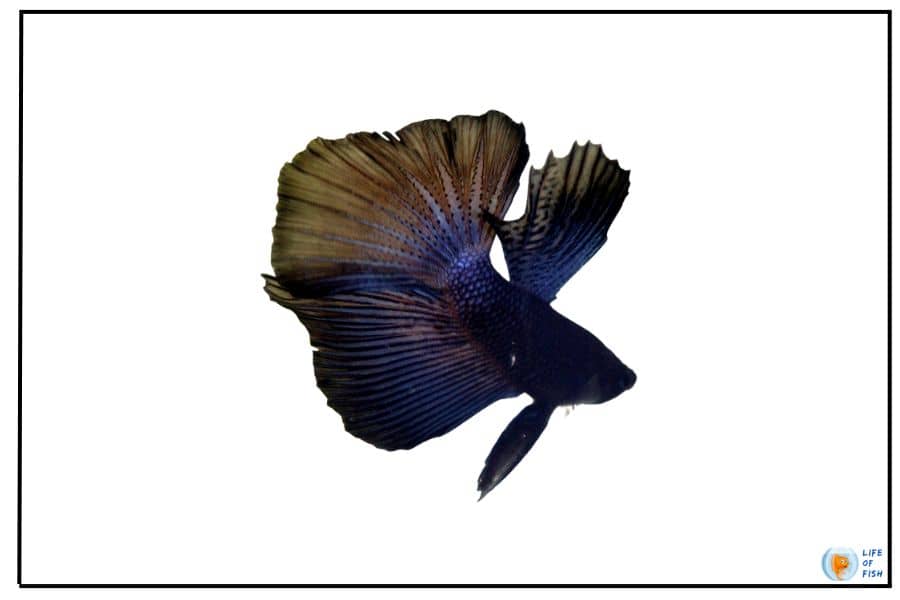
Melanophore Bettas
The Melanophore Bettas produced by melanoma are very different from what you see in wild and Black Lace Betta. Those Melanophores Bettas accumulate and become very sticky, because of this they become so dense black coloration. A high degree of speckles is spread all over the fins of this Betta. Because of these speckles, the fish takes on a darker color. Actually, these are the “balls” of the melanophore. information from early studies taught us that, these fish contain extra adhesion proteins in there body.
Black Lace Betta
Black Lace Betta has darker colors. However, their color is rarely close to the intensity and depth found in Melano Black Betta. Many Black Lace Betta fish have too much iridescence on fins and it adds extra beauty to them. The ends of Black Lace Betta fish’s fins should be cellophane or clear in color. Fins have a lacy appearance due to this coloration, and that’s how this beautiful fish is named Black Lace Betta. Some people misunderstand Black Lace Betta as Melano Butterfly Betta. Because the Butterfly Betta’s fins also may fade to smoke or clear. However, Butterfly Betta has blue-black or very dark black body color but Black Lace Betta is not like that.
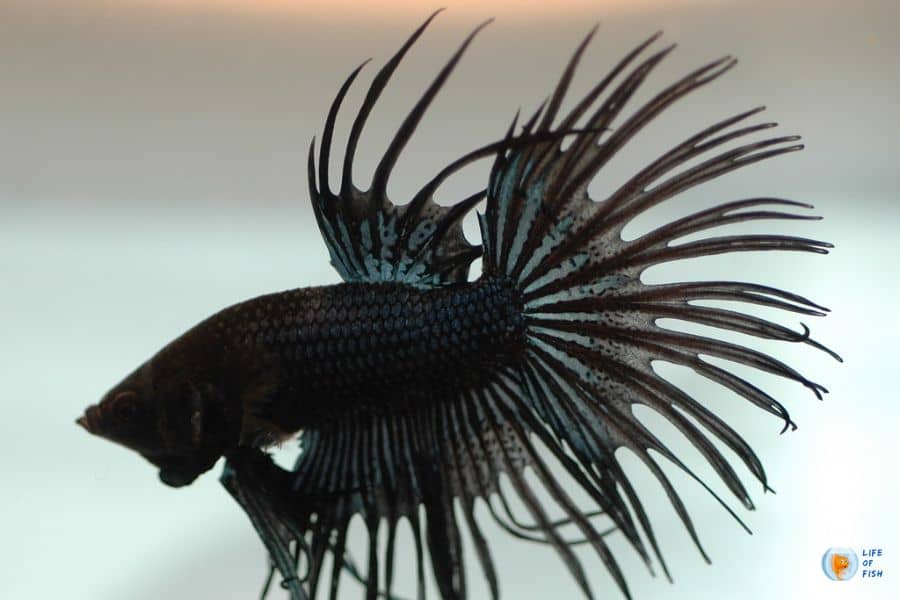
Black Orchid Betta
The coloration of the Black orchid Betta, species is not a marble-based black color but is more of a melano type. This species has large amounts of steel iridescence, especially on their fins. The tag, describes any fish from Half Moon to Plakat that have similar coloration in any different form. However, this Black orchid Betta is almost always derived from marble. Unlike royal blue betta, the Black Orchid Betta’s fins are dark black color with steel blue stripes, usually forming a pattern like a butterfly. The iridescence of this is not limited to its fins. Most Black Orchid Bettas develop a red wash, which is another indicator of the influence of the marble gene.
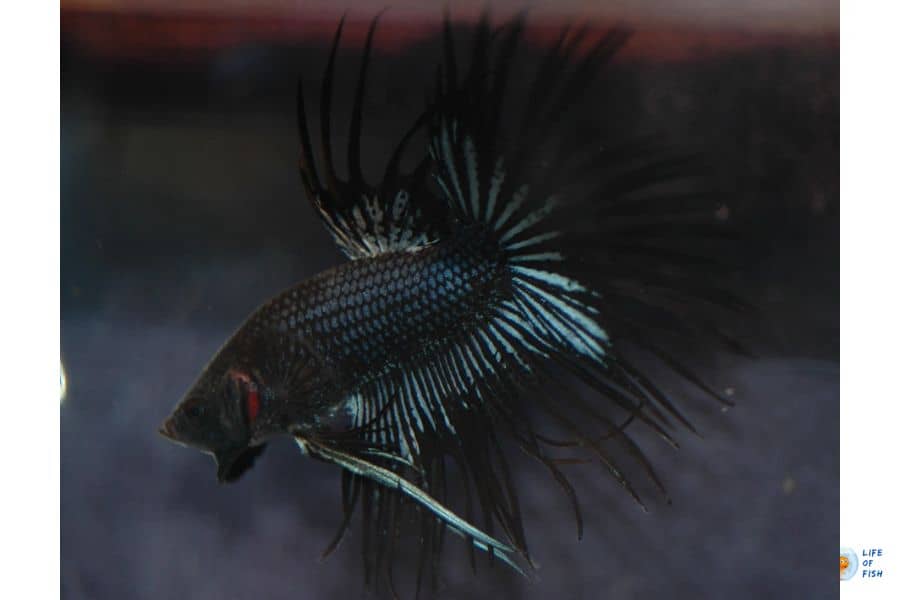
Black Devil Betta
The increase in red color gave rise to a new type of Black Betta called the Black Devil, which is represented as a marble type black. And their fins are red, red color has appeared in their fins than iridescence.
Black Ice Betta
It is one type of black and it is derived from and appears in marble spawns. Black Ice varies in intensity from other species. it has an iridescence appearance on the body and fins. The iridescence in Black Ice Betta fish can be green, royal, or steel color. Over time, the percentage of Black Ice offspring from selectively bred Black Ice spawns has increased, but this species is not yet truly breeding.
Copper-Based Black Betta
Another interesting types of black betta fish is Black Copper Betta. It is hybrid species of female black melanoma and copper Betta and they generate offspring that have a mix of deep black and metallic coloration in scales.
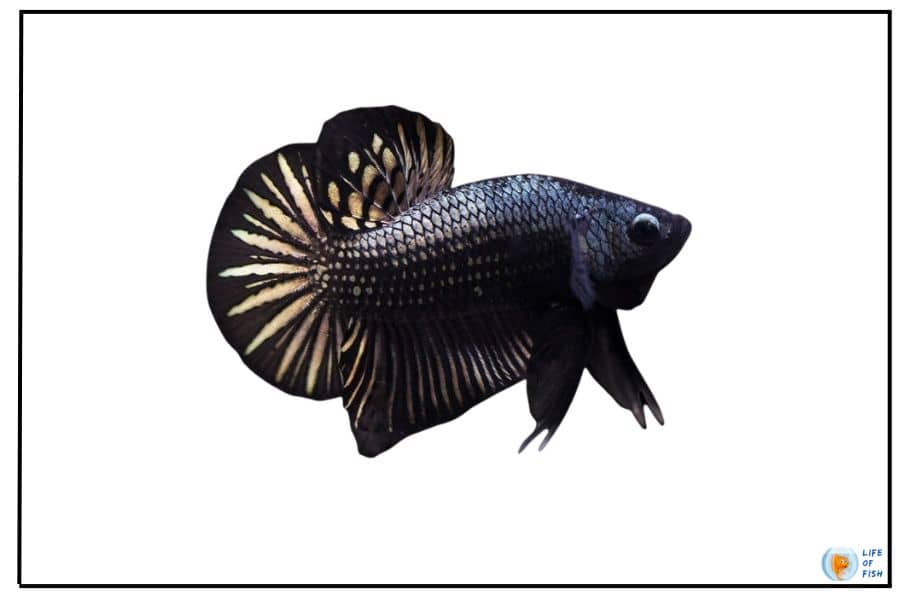
Tail variations
Crowntail Black Orchid Betta
Black Orchid Crowntail Betta is the one of popular variations of this type of Betta and as the name explained, male Crowntail Betta has long caudal fins with large extensions that can reach up to eight inches in diameter, about three times the size of a fish’s body. Crowntail Betta has long spikey crown shape fins. That is how this species has taken this name. These fish are really attractive when their crown combined with the attractive colors of the fish. Same as other betta species female betta does not have colorful fins as a male betta.
Halfmoon Orchid betta
This fish has a beautiful, large tail that takes the shape of a half-circle and it looks like a half-moon. Even though these species are highly bred in captivity, you will not find them in the wild. Betta is commonly bred among experts to exhibit at Betta shows. It may be a bit challenging to breed them. They have more aggressive behavior.
Half Moon Plakat (HMPK)
The Plakat or Plakad Black orchid Betta is one of the short-tailed Bettas that is more closely akin to wild betta species or traditional fighting Bettas. Male Palket Betta has elongated ventral fins, a rounded caudal fin, and a sharply pointed anal fin. The term Palkat is often abbreviated as “PK”. There are 3 subcategories of this type of tail. The traditional Palkat tail is rounded, sometimes it is with a point. There is a Half Moon Plakat (or “HMPK”) due to selective breeding and cross-breeding where the tail has a 180-degree spread when flared.
Read Next : Black Orchid Betta Care | Anabantoids | All You Need To Know
